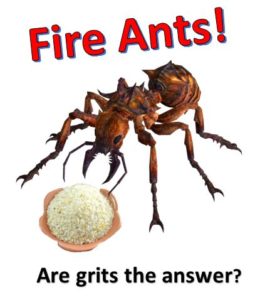Fire ants are a terrible menace. They are small, easily unobserved as they crawl up your leg. Then at the release of a pheromone signal they all sting at once. And those stings are painful! They can hurt and itch for weeks — even leave scars. Fire ants don’t bite. They sting like wasps and bees, injecting venom with a smooth stinger. They can be quite dangerous to small children and animals as well as to adults allergic to their venom. Is there any safe, non-toxic way to get rid of them — to eliminate their colonies?
Home remedies abound. Here are a few:
Grits. Pour about 1½ cups of uncooked grits in the opening at the top of a mound or sprinkle them on any trails you find. (Opinions differ as to whether to use instant or regular grits.) The ants supposedly eat the grits, and when they drink water, the grits expand in their stomachs and the ants explode! If necessary, repeat the procedure.
Another theory about grits is that the grits grow rancid and this makes the ants leave.
Does It Work? The truth is that adult fire ants don’t eat solid food. They carry it to their larvae, who eat it and regurgitate liquid which the adults eat. (Yuck!) However, fire ants don’t like anything being poured into their mound. Pouring in grits, rice, sugar, coffee grinds, household cleaners, etc., could motivate them to build another entrance, a new mound. Thus, they might desert the “treated” mound and relocate elsewhere. (HINT: If you use any kind of ant bait, sprinkle it around the mound; don’t pour it in the top.)
Sugar & Boric Acid. Dissolve sugar and boric acid in water and put the liquid in jar lids. Place the jar lids on ant mounds or trails. The sugar acts as bait and boric acid kills the ants.
Does It Work? Unfortunately, sugar is not bait to fire ants. The sugar/boric acid solution does work well for the pesky “sugar ants” that trail into the kitchen, however. (Boric acid is also effective against cockroaches. Sprinkle it along baseboards. Boric acid eats into their shells.)
Orange Oil. This is an organic product sold in the garden section of home improvement stores. It acts as an insect repellent.
Does It Work? Orange oil seems effective against some insects, but most likely just causes fire ants to relocate if it is poured into or around their mounds.
Are There Any Nontoxic Solutions?
According to the July 24, 2015 post on rodalesorganiclife.com/garden bucketing and use of diatomaceous earth are two nontoxic methods of dealing with fire ant colonies. In addition there is an organic pesticide from Dow Agrosciences called Spinosad and beneficial nematodes work to kill ants.
Directions for Bucketing: This procedure consists of digging up the fire ant mound along with about a foot of soil under the mound, dumping it into one or more buckets, and then “drowning” the mound. Before digging, tuck your pants into your socks to protect your legs, and sprinkle powder or cornstarch on the shovel and the buckets to prevent the ants from crawling out. It’s best to dig up the mound when most of the ants are in it — usually in the morning. Fill the buckets about 3/4 full with mound and ants to allow room to add water.
Either dump the ants in a place where they’ll be no problem or drown them. If you drown them, add some dish soap and water from a hose and mix them in the bucket. Leave the buckets overnight to kill the ants.
Diatomaceous Earth. This looks like white powder, but it is shells or silica ground up exceedingly fine. Its edges are like cut glass and injure any jointed insect or slug that crawls over it, causing it to dehydrate and die. You can use it with any sprayer or blower that handles dry substances. But be very careful not to breathe any in or get it in your eyes! Wear protective gear. Think of it as very fine ground-up glass.
Spinocad. This is an organic pesticide “derived from a naturally occurring soil dwelling bacterium called Saccharopolyspora spinosa, a rare actinomycete reportedly collected from soil in an abandoned rum distillery on a Caribbean Island in 1982 by a scientist on vacation!” See: http://dowagro.com/turf/prod/spinosad.htm
Beneficial Nematodes. Nematodes are microscopic worms that live below the soil. They are generally clear or white and are unsegmented, like earthworms. A handful of dirt can contain thousands of them. They are parasites and affect a number of plants and animals. Some are beneficial in that they are used to control insects.
A nematode enters the body of an insect grub or larvae. Within 48 hours the insect host either dies or is unable to reproduce. The nematode then moves on to its next host.
Nematodes prefer moist soil. If it does not rain, water the treated soil every week or ten days. Buy your nematodes from a reputable source. They should come from a refrigerator when you buy them and must be kept cold. Follow the directions for application carefully.
Good luck!
Record your battle against fire ants in your GARDEN JOURNAL & PLANNER. Note what you used that was effective against them in the form “Suppliers, Orders & Contact Information” in the Handbook of Useful Garden Forms section of your Journal & Planner.
GARDEN JOURNAL AND PLANNER
by Michelle Marsh
Amazon.com: amz.to/2r7zwAb
AmazonUK.com: amzn.to/2LnllyA


